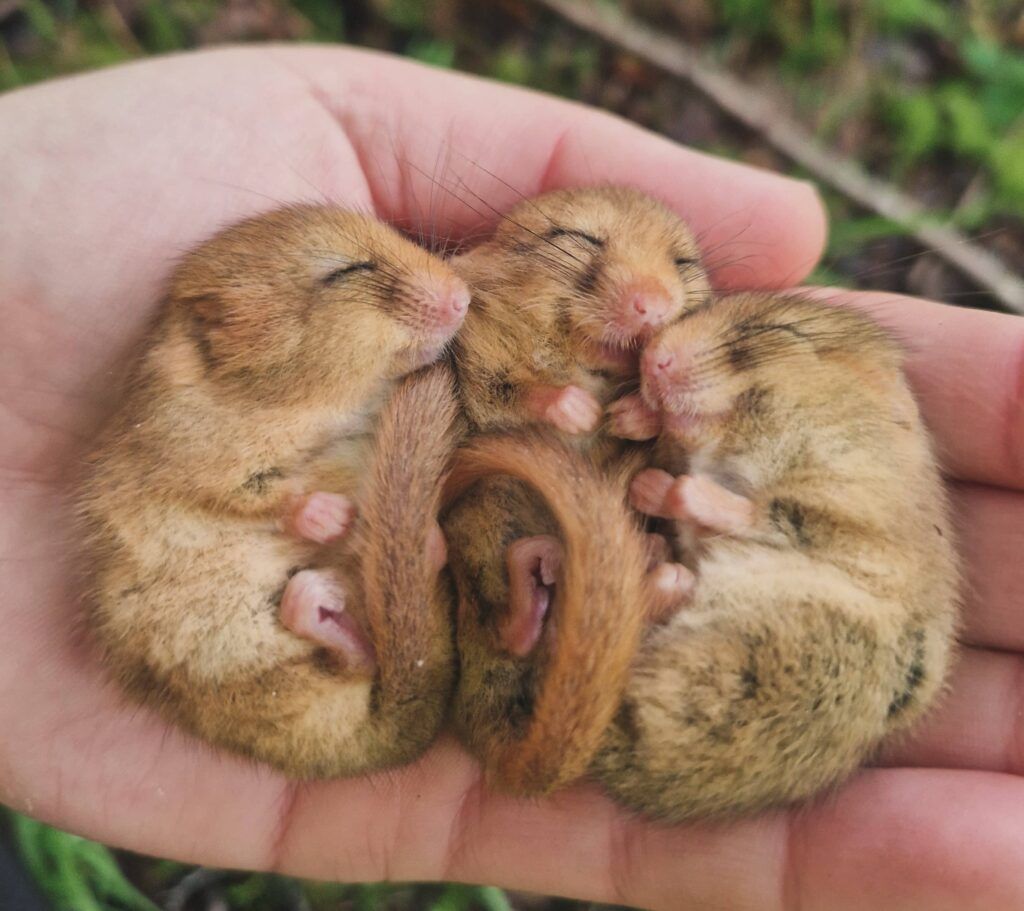If you’ve ever lifted the lid of a nest box on a cool morning and found a curled-up dormouse barely moving, you’ve probably witnessed torpor in action. This fascinating state – an almost mini-hibernation – is one of the most remarkable adaptations of the hazel dormouse. Thanks to the dedication of volunteers like you across the country, we’re learning more than ever about how and why dormice use torpor, and what it might mean for their future.
Based on data from more than 380 sites and over 50,000 recorded adult dormouse observations between 1993 and 2018, the NDMP provides a powerful lens through which to view how dormice behave across the seasons and landscapes of Britain.
What is torpor?
Torpor is a short-term survival strategy that helps dormice conserve energy. It’s different from full hibernation, which happens at ground level in winter, but it still involves a drop in body temperature and activity. Dormice enter torpor when local conditions aren’t favourable – a way to ride out short periods when food is scarce or weather turns cold.
But torpor isn’t just a curious behaviour; it offers valuable clues about how dormice are coping with their environment and changing seasons.
What we’ve learned about torpor
Using NDMP data, researchers have been able to explore both site-level and individual-level factors influencing torpor use. This has revealed some fascinating patterns.
Habitat and location seem to play an important role. Dormice were more likely to enter torpor in the west of Britain and at higher-elevation sites. Those living in ancient woodland or well-connected patches of broadleaf trees also showed higher rates of torpor. These differences could relate to local foraging opportunities, dispersal routes, or subtle variations in climate.
The likelihood of torpor also depends on the dormouse itself. Males were more prone to torpor in August, while females were more likely to use it in September. Dormice sharing boxes with litters were far less likely to be torpid, and the more dormice in a box, the less likely any of them were to be in torpor. Lighter individuals tended to use torpor in spring and summer, conserving energy when food was limited, whereas heavier dormice used it more in autumn, perhaps as preparation for hibernation.
Weather also matters. Cooler, wetter days saw more torpid dormice, while warmer spells kept them active. High seasonal rainfall appeared to encourage torpor too, possibly because wet conditions make foraging more difficult.
What this means for dormouse populations
Researchers also looked at how torpor use relates to dormouse numbers and breeding success. Interestingly, sites where torpor was more frequent tended to have lower dormouse abundance and fewer breeding events. Litter sizes were smaller too.
That might sound worrying, but torpor could equally be a clever survival tactic, helping dormice conserve energy and endure poor conditions. It may not signal unhealthy populations, but rather show how flexible dormice can be when resources fluctuate.
Ultimately, these findings underline how finely balanced their lives are. Torpor is a vital tool for survival, yet relying on it too often may limit opportunities to feed, breed and raise young.
Why this matters in a changing climate
As the climate continues to shift, understanding torpor becomes even more important. The dormouse’s seasonal rhythms are closely tied to temperature and rainfall, and subtle changes could have far-reaching effects.
Warmer springs might mean fewer dormice enter torpor early in the year, potentially leaving them more active – and hungrier – for longer. Wetter weather, on the other hand, could increase torpor use and reduce feeding or breeding time. The next stage of this research will model how future climate scenarios could affect dormouse behaviour and populations, with results expected soon.
You make this possible
If you’re reading this in Dormouse Tales, you’re likely one of the hundreds of volunteers who make this research possible. Every careful box check, every note and observation contributes to this remarkable dataset. Without your dedication, we wouldn’t have the insight needed to understand how dormice are adapting to our changing world.
By studying torpor and its causes, we can better protect dormice by improving habitat connectivity, monitoring climate impacts, and supporting long-term research through the NDMP.
So next time you peek into a nest box and find a tiny dormouse curled up in a ball, remember – that little sleeper is part of a much bigger story. It’s teaching us about endurance, adaptation and the quiet brilliance of one of Britain’s most endearing mammals.
With thanks to all NDMP volunteers – past, present and future. You’re not just checking boxes; you’re helping to write the story of Britain’s dormice, one observation at a time.
To read the full research paper, visit Springer Link.
Written by Charlotte Armitage.
Image credits Charlotte Armitage

